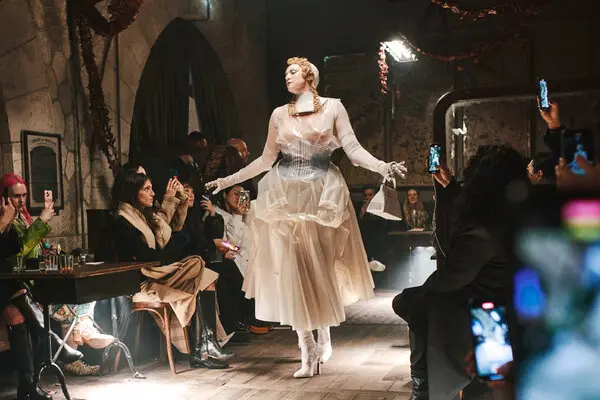The French luxury fashion house that is Maison Margiela had yet another breathtaking show for Paris Fashion Week. John Galliano, the creative designer for Margiela, is known for his avant-garde designs and continued his incredible reputation with the Spring/Summer Artisanal collection. The show took place in an alley under the Pont Alexandre III next to an antique 1920s club during a foggy, drizzling night. The ambiance of the show perfectly reflected the inspiration of the Hungarian-French photographer Brassaï who was known for his work that captured the emotion and darkness of underground Parisian nightlife in the 1930s.
The main theme reflected through every piece was the theme of the body. This show held a strong framework of historical representations of womanhood through underpinnings, which are what women would wear under their dresses in the 1800s. Exaggerated bodies with corsets and padding displayed this image of hyperbolic femininity that can be seen in a modern context as these past methods have transitioned into surgeries. This idolized state of the body was not only displayed on women — men were also in corsets. It was fascinating to see how these pieces were equalized among all of the models. When looking at looks 28-31, we can see transparent fabric draping over the model’s clothes, revealing the state of this exaggerated body. As we continue to look up at the models, we see that their eyes cannot be clearly seen; this is representative of the anonymity of the underground life that occurred in the 20s.
In the last four looks, Galliano honed in on the theme of discarded dolls as the models wore gloves representing ball joint dolls from the 1800s that tie into the underpinning of each piece of clothing. Each of these four models was also seen wearing headpieces that could resemble old dolls that were missing hair, displaying an old and forgotten toy. Using fabrics not common to fashion, like latex, goes back to the original designer, Martin Margiela, who took unconventional things for clothing to make something new. Latex, which isn’t typically imagined as clothing, was reimagined as Galliano took this strategy by Martin Margiela and turned it into high-quality fashion.
The makeup throughout the whole show was done by Pat McGrath and was something that I had never seen before. She made the skin look as if it were porcelain to maintain the theme of dolls. Each model’s skin reflected off the light exactly like a doll would and had this unrealness to it to transcend the viewer into another world, as if they were watching life-size dolls walk past them. Something interesting to point out was the use of hair for some of the models. They mimicked the shape of the hats that were also used to create a consistent theme of 1800s fashion that is seen through every detail. Margiela collaborated with Christian Louboutin, so every shoe had a red bottom, which also paid homage to the first-ever Margiela show where the models walked on red paint to make the bottom of their shoes red.
Galliano has kept the image of Maison Margiela that Martin Margiela built when he first made this fashion house. The social commentary that Galliano continues to make with each show is something that Martin Margiela would be proud to see continue in his legacy. This fashion show wasn’t just a display of clothes but a performance where each model blended the art of storytelling with the exquisite tailoring of Galliano. The vulnerability portrayed by each model as they represented these discarded dolls provided a unique situation with a universal theme of the human condition that tugged at the heartstrings of those who watched the show. Emotions surged to the surface while watching; it was almost as if these dolls, rather than being controlled, were controlling the audience instead.
Galliano is constantly reinventing what we consider fashion, making each show he puts out more exciting and not using the conventional techniques that other houses use to bring uniqueness to the fashion world. Using fashion as more than just clothes and transforming it further, into a broader form of art, opens a new realm for audiences as we can see more of a story being told, rather than just clothes on a model.









